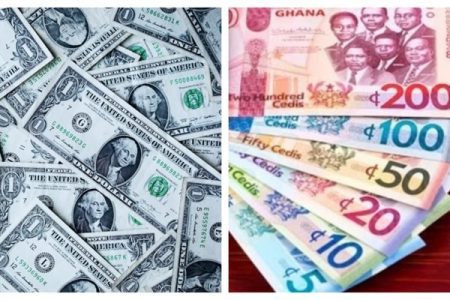The cedi is expected to revert to a path of depreciation from the second half of 2025, according to a new report by S&P Global Ratings.
It forecasts renewed currency pressure amid persistent fiscal and structural weaknesses
The global credit ratings agency, which recently upgraded Ghana’s foreign currency rating to ‘CCC+/C’, said the cedi’s relative strength in early 2025 is unlikely to be sustained due to a host of economic and structural challenges.
The report comes just months after the cedi posted a 9.6% appreciation against the U.S. dollar between January and April 2025, buoyed by record trade surpluses, rising remittances, and an influx of foreign exchange from gold exports.
But S&P warns that these gains could be short-lived.
A managed float facing mounting pressures
S&P attributes the cedi’s short-term stability to Ghana’s managed float regime, under which the Bank of Ghana intermittently intervenes in the foreign exchange market to control volatility. While the central bank’s interventions have helped shore up confidence and narrow exchange rate spreads, S&P cautions that underlying vulnerabilities remain unresolved.
“The recent appreciation of the cedi is not likely to persist,” the agency said.
“We anticipate continued depreciation from the second half of 2025 as structural imbalances, inflationary persistence, and fiscal constraints reassert themselves.”
High inflation and interest rates undermine stability
At the core of Ghana’s macroeconomic pressures is stubbornly high inflation.
Although the pace of price increases has moderated from earlier peaks, inflation remains well above the Bank of Ghana’s official target band of 6%-10%—a trend S&P expects to persist until at least 2028.
Elevated inflation has weakened consumer purchasing power and eroded business profitability.
This has forced the central bank to maintain high interest rates, further dampening private sector credit demand.
Meanwhile, the banking sector, though recapitalized in 2023 following the domestic debt restructuring, is showing signs of strain.
Non-performing loans (NPLs) rose to 21.8% by the end of 2024, up from 20.6% in 2023, underscoring lingering credit risk in the system. Nevertheless, S&P believes the sector remains adequately capitalized for now.
Debt service costs still a major drag
Another major concern flagged by S&P is Ghana’s still-substantial interest burden, which, despite dropping from nearly 48% of government revenue in 2021–2022 to 25% in 2025, remains among the highest in sub-Saharan Africa.
The country’s ongoing IMF-supported fiscal reforms aim to balance capital investments with critical social spending. However, tight fiscal space continues to constrain policymaking. Interest costs are projected to remain elevated, posing a risk to both currency stability and long-term fiscal consolidation.
S&P forecasts that the government’s ambitious plans—including achieving a primary surplus of 1.5% of GDP in 2025 and capping expenditure growth at 9.2% per year through 2028—will likely be tempered by political pressures, inflationary costs, and public discontent.
Gold and remittances lift external buffers—for now
One of the few bright spots in Ghana’s macroeconomic picture is its improving external position.
In 2024, the country recorded its highest-ever current account surplus of $3.58 billion, or 4.4% of GDP.
This was driven primarily by a 53.2% increase in the value of gold exports—thanks to both higher volumes and prices—as well as a 34.1% rise in net remittances.
These developments helped Ghana rebuild its usable foreign exchange reserves by $2.8 billion, bringing the total to nearly $4.6 billion by early 2025.
However, S&P warns that these improvements are vulnerable to shocks, including changes in gold prices, remittance flows, and exchange rate expectations.
Moreover, the drive to boost gold exports through formalization of artisanal mining may have negative long-term consequences. The report notes that increasing small-scale gold mining is degrading arable land, polluting water sources, and undermining cocoa production—a critical export and employer in rural areas.
Political and social uncertainties cloud reform prospects
S&P also flags political uncertainty and social policy developments as potential headwinds.
While the government has launched legislative reforms aimed at strengthening public financial management—including amendments to the Public Financial Management Act and the establishment of an independent fiscal council—these reforms remain largely untested, especially in an election year.
Compounding the risks is the controversial “Promotion of Proper Human Sexual Rights and Ghanaian Family Values” bill, passed by Parliament in 2024 but yet to be signed by the President.
If ratified, the bill could jeopardize much-needed World Bank support, following precedents in Uganda where similar legislation triggered funding cuts.
Debt restructuring boosts ratings, but risks remain
The recent ratings upgrade from ‘SD’ (Selective Default) to ‘CCC+’ reflects progress in restructuring both domestic and external debt.
In October 2024, Ghana completed a Eurobond exchange and is close to finalizing offers to restructure commercial bank loans amounting to $2.6 billion.
The debt overhaul, which also includes a memorandum of understanding with bilateral creditors signed in January 2025, has significantly reduced Ghana’s debt service burden.
As a result, interest payments have dropped to just over 20% of revenues for 2025 and 2026.
Still, nearly half of Ghana’s total government debt—62% of liabilities or 49% of GDP—is external. With more than 45% of total debt denominated in foreign currency, S&P notes that Ghana remains highly exposed to exchange rate shocks.
Even modest currency depreciation could quickly inflate debt service obligations and fiscal deficits.
Growth remains resilient amid constraints
Despite its many challenges, Ghana’s economy has shown surprising resilience. Real GDP growth reached 5.7% in 2024—its highest rate since 2019—driven by a rebound in the industrial and services sectors.
While the government’s gold purchase program has bolstered formal trade and FX earnings, S&P cautions that growth sustainability depends on the success of fiscal reforms and effective public investment.
Moreover, the agricultural sector remains fragile. Cocoa production is increasingly threatened by erratic weather patterns, plant diseases, and competition for labor and land from unregulated gold mining activities.
Outlook stable, but fragile
S&P’s stable outlook on Ghana’s ratings reflects the delicate balance between improving external buffers and ongoing fiscal reforms on one hand, and elevated debt service costs, inflation, and untested fiscal institutions on the other.
The agency could upgrade Ghana’s rating further within 12 to 18 months if the government completes restructuring of all commercial debt and continues rebuilding FX reserves beyond current projections.
Conversely, any setback in fiscal performance or external financing—particularly if reform momentum stalls—could trigger another downgrade.
The cedi’s performance will be a key signal of investor confidence, the credibility of economic reforms, and the country’s ability to transition from stabilization to sustained growth.

